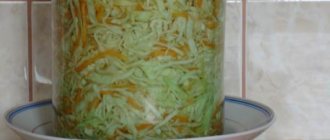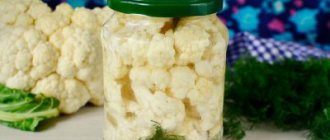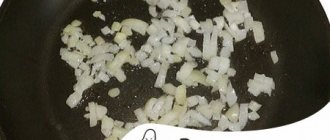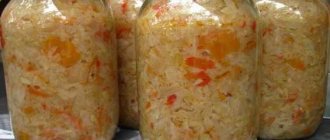Beijing cabbage has a more delicate consistency than white cabbage. Therefore, pickling Chinese cabbage for the winter happens quickly, just like pickling boletus mushrooms; the main thing is to choose a good marinade that will have a taste that suits you. For appetizers you need to select more piquant mixtures, and for salads you can take a more gentle mixture.
If you are interested in these recipes, then perhaps you will also find the options for preparing salted purslane or pickled physalis useful.
Kimchi recipes
Korean-style Chinese cabbage can be a real find for lovers of spicy and spicy cuisine. The pickled product contains various seasonings, salt, and sometimes vinegar. Kimchi can be supplemented with garlic, onions, carrots, various types of hot and bell peppers, and fruits. Greens, daikon, celery, and mustard go well with cabbage. It is possible to prepare a delicious kimchi dish only if the ingredients are correctly combined. So, we will try to describe the best options for preparing Beijing pickled cabbage in more detail.
A simple recipe for beginner cooks
The proposed recipe allows you to prepare kimchi from a limited number of available ingredients. They can be easily found in any store, which makes the task much easier. So, for one recipe you will need 3 kg of Chinese cabbage itself, as well as 3 heads of garlic, hot red pepper and 250 g of salt.
The process of preparing pickled snacks is very original:
- Cut the head of cabbage into 2-4 parts depending on the size of the vegetable. Divide it into leaves.
- Each leaf should be rinsed with water, shaken and rubbed with salt.
- Fold the salt-treated leaves tightly together and place in a saucepan for a day. Leave the container warm.
- Peel and press the garlic through a press. Add hot ground pepper to the garlic mass. The amount of pepper and garlic should be approximately equal.
- After salting, cabbage leaves should be washed with water and rubbed with prepared hot paste.
- Place the pickled leaves in a glass jar or pan for later storage. You need to eat kimchi after 1-2 days. By this time, the vegetable will be saturated with spicy aromas.
Before serving, pickled Chinese cabbage leaves can be cut into pieces or carefully placed on a plate in the shape of a nest. It is also recommended to pour vegetable oil over the dish.
Recipe for spicy cabbage with added sugar (thin slices)
The combination of hot pepper, garlic and salt can be offset with a small amount of sugar. In this case, the cabbage will be more tender and everyone will like it. Thin slicing will allow you to marinate the vegetable faster and avoid chopping the leaves before serving.
The proposed recipe is designed for 1 kg of cabbage. For marinating you will need 1 tbsp. l. salt and 0.5 tbsp. l. Sahara. Kimchi gets its spicy aroma and pungent taste from a paste made from ground chili pepper (1 tbsp), a pinch of salt, a head of garlic and a small amount of water.
To prepare kimchi, Chinese cabbage must be chopped into strips 1.5-2 cm wide. The resulting vegetable noodles should be placed in a saucepan or basin. Sprinkle the product with salt and sugar. Lightly mash the vegetables with your hands, mixing the added ingredients. To marinate, place pressure on top of the cabbage. Leave the container warm for 10-12 hours.
You need to prepare the paste for Korean cabbage in advance so that it has time to brew. To prepare, mix a pinch of salt and pepper and add a little boiling water to the mixture so that you get a liquid consistency (similar to pancake dough). Add garlic squeezed through a press to the cooled paste. Mix all ingredients and leave in the room for 10 hours.
After the cabbage has been marinated in salt and sugar, it needs to be washed and slightly dried, then put back into a large container and mixed with the spicy paste. Marinate for another 4 hours, then stir the cabbage and leave it again for 4 hours. After this, the kimchi can be placed in glass jars and tightly closed. It is recommended to serve the spicy appetizer with the addition of vegetable oil.
Kimchi with vinegar
A little sourness will not hurt the cabbage, since the vegetable itself has a relatively neutral taste. The following recipe allows you to prepare a salad that harmoniously combines sweetness, saltiness, spice and acidity. The recipe is designed for a small amount of ingredients, which one family will eat quickly enough, so if you want to stock up on delicious cabbage for future use, then the number of ingredients should be increased.
Beijing cabbage - simple and tasty vegetable recipes for every taste
Just a few years ago, Chinese cabbage was a real delicacy that was delivered from China to the shelves of our stores. Today this product can be easily purchased at a simple vegetable stall. When choosing a vegetable, you should pay attention to the leaves. They should be juicy and crispy when broken. Peking cabbage is used to prepare dishes in which white cabbage is usually used. It is salted, pickled, fermented, and made into salads and other dishes.
- 1. Rules for storing and collecting raw cabbage
- 2. How to prepare raw cabbage
- 3. Beijing cabbage with sweet pepper and onion
- 4. Recipe for cabbage marinated “like in Japan”
- 5. How is Peking cabbage different from cabbage cabbage?
- 6. Classic kimchi recipe (kimchi)
- 7. Spicy and spicy kimchi recipe (kimchi)
- 8. Secrets of storing and cooking cabbage
Yellowed or limp heads of cabbage are evidence that the product was damaged during transportation and is therefore unsuitable for food. The smell of rot is a direct sign of the end of the vegetable’s shelf life.
Storing Chinese cabbage at home requires certain rules: each head of cabbage must be wrapped in cotton cloth and kept in the refrigerator for no more than one week.
There are also simple rules for storing the product immediately after collection:
- 1. Cabbage should be dry. You can harvest only after the last drop of water has evaporated from the vegetable.
- 2. It is impossible to wait long for the harvest, since with the onset of the first frost the process of rot in the cabbage begins. If Pekinka sits for several days at temperatures below zero, it will be unsuitable for consumption.
- 3. Heads of cabbage are cut right down to the leaves, without damaging the central veins.
- 4. In winter, only young fruits that do not have the slightest damage are stored in cellars.
- 5. The top leaves of the cabbage are removed, but the vegetable is not completely stripped. The thing is that the leaves of the upper layers protect the product from drying out from the inside, because the cabbage has nowhere to get water during storage.
It is also necessary to create certain comfortable conditions for the preservation of heads of cabbage. You will have to monitor not just the air temperature, but also the humidity, control the content of carbon dioxide and oxygen in the room where the vegetable lies. If you follow all the rules, the cabbage can last for five months without damage or damage to the fruit.
Air humidity should be kept at 95-98 percent; a lower figure will lead to the appearance of fungi and rot. Temperature: two or three degrees. Also, fruits or vegetables other than heads of cabbage cannot be stored indoors, because they emit ethylene, which Beijing treats very unfavorably.
- Broccoli for the winter - simple, proven recipes
- Pickling honey mushrooms for the winter - the best recipes for every taste
- Tsitsak for the winter: simple and tasty recipes for cooking peppers
In order not to spoil all the cabbage that is intended for twisting, you need to prepare the product for the winter.
- Before the procedure, the cabbage is not washed so that it does not absorb more liquid than required for the recipe.
- After assembly, it is cooled to storage temperature, laid out in boxes, and covered with perforated foil to minimize moisture loss from the vegetable.
- All possible damaged or frozen leaves are removed from the cabbage, and locally damaged areas are cut out with a knife.
Ingredients for making Korean cabbage:
- kilogram of Beijing;
- half a kilogram of sweet bell pepper;
- half a kilogram of onions;
- one chili or bitter pepper;
- one hundred milliliters of vinegar;
- fifty-five grams of salt;
- one hundred and ten grams of sugar;
- liter of boiled water.
Step-by-step quick cooking:
- 1. First of all, the vegetable is disassembled into leaves, which are then cut into large pieces.
- 2. Sweet peppers are washed, cleared of seeds, and cut into thin strips. Hot chili peppers are also washed and chopped into cubes.
- 3. Onions are peeled. It needs to be cut into half rings, then mixed with the rest of the vegetables in a large bowl or pan.
- 4. For the brine, you need to boil water, add all the spices and cook for five minutes.
- 5. Place bay leaves and peppercorns on the bottom of a sterilized jar, then fill the containers with cabbage and vegetables and sterilize a second time in boiling water.
- 6. Close the containers with tin or plastic lids and store them in a dark room or refrigerator.
To marinate the product you will need the following ingredients:
- kilogram of Chinese cabbage;
- five heads of garlic;
- ten peppercorns;
- one hundred milliliters of table vinegar;
- seventy grams of salt;
- one hundred and fifty grams of sugar;
- liter - one and a half water.
First of all, cut the head of cabbage in half, after which each of the two halves is chopped 2 centimeters wide. Garlic is passed through a press. Next, the vegetable is placed in already prepared and clean jars, alternating each layer with garlic and pepper. It is this procedure that will allow you to achieve that very taste of a Japanese snack.
Start preparing the brine or marinade for the cabbage. Add sugar, salt and vinegar to boiling water and cook for fifteen minutes. The liquid should be a little salty. If this is not the case, then you can adjust the taste of the brine using water, sugar or salt.
Pour the hot marinade over Chinese cabbage in jars, cover with lids and leave to cool at room temperature. When the container with vegetables has cooled, the cabbage will settle a little; it can be closed and hidden in a cellar or garage for further storage.
There are often no differences between the recipes for salting and marinating Chinese and white cabbage. These two products are related, so they are not so different. If you don’t have a recipe for Chinese cabbage at hand, then you can safely use any simple cooking method.
The main thing is to choose heads of cabbage with green or transparent leaves or veins. Size also matters. Medium heads are the most suitable. But it is best to cook cabbage according to a recipe that was invented in the country where Beijing cabbage comes from - China.
For cooking you will need the following products:
- three kilograms of cabbage;
- five pods of hot red pepper;
- three heads of garlic;
- thirty grams of salt;
- other spices to taste.
Divide large heads of cabbage into four parts, medium ones into two, and leave small ones whole. Rinse each thoroughly with running water and then rub with salt. Leave the vegetables in a cool place for a couple of days to allow the salt to be absorbed.
After a couple of days, pass the garlic through a garlic press and mix with pepper. Rinse the cabbage to remove excess salt, rub with a mixture of garlic and pepper. Next, put it in jars, leave it in a warm place for several hours, seal it and hide it for storage in a designated place.
Spicy cabbage with pear is an original kimchi recipe that came to us from the Far East. Products for cooking:
- one large head of cabbage;
- two medium-sized pears;
- three heads of garlic;
- five green onions;
- three centimeters of peeled ginger root;
- ground red hot pepper;
- four tablespoons of salt;
- two hundred milliliters of water.
Peking cabbage is cut into small pieces of three centimeters, placed together with the pear in a prepared and sterilized jar with a wide neck. All the salt is poured into it. Then you need to knead the vegetable well with your hands, mix thoroughly and knead again. Next, the product is filled with water to the very top, put in the refrigerator and kept there for two days.
How to quickly pickle Chinese cabbage - recipe with photo
We free the forks of Chinese cabbage from the top leaves. They tend to be wilted and unappetizing. Wash and shake off the water. Then cut into two halves.
Cut each or just one part of the cabbage into large strips.
Place the slices in a convenient spacious bowl.
Peel the carrots, wash them and grate them on a Korean carrot grater, add them to the cabbage.
We also send chopped garlic there. We adjust its quantity to suit ourselves. If you like it spicier, you need to take 4-5 cloves.
Add chopped coriander. You can take spices for Korean carrots or other spices that you like.
Then there are two possible options:
- Prepare the marinade and pour it over the cabbage. Add the ingredients to the chopped vegetables and mix well. In the first case, you will need water (100 ml), in which sugar, salt and vinegar are dissolved. The marinade is mixed with vegetable oil and poured into vegetables. Press them down with a weight and, covering them with film, put them in the refrigerator for a day.
- In the second, like mine, we simply add sugar, salt, vinegar, and vegetable oil to the cabbage. Mix everything well and leave for a day, covered with cling film, in the refrigerator. During this time, you can stir the contents of the container twice so that the marinating proceeds evenly.
After a while, the pickled Chinese cabbage can be served, stirring well again. This way, the released juice, oil, and vinegar will evenly cover the vegetables.
Serve the finished cabbage in portions or on a common platter.
Spicy, moderately spicy, the cabbage turns out crispy and tender. A very tasty addition to main dishes.
Beijing cabbage has a more delicate consistency than white cabbage. Therefore, pickling Chinese cabbage for the winter happens quickly, just like pickling boletus mushrooms; the main thing is to choose a good marinade that will have a taste that suits you. For appetizers you need to select more piquant mixtures, and for salads you can take a more gentle mixture.
If you are interested in these recipes, then perhaps you will also find the options for preparing salted purslane or pickled physalis useful.
Pickled Chinese cabbage recipes
This preparation involves marinating cabbage in large pieces, but in some cases it is inconvenient to use. Then you can simply cut it into strips or cubes before use. Then it can be used in any dish, regardless of how it was originally prepared.
Required ingredients:
- Beijing cabbage – 1 kilogram;
- Hot pepper – 1 pod;
- Sweet pepper – 0.5 kilograms;
- Onion – 0.5 kilograms;
- Apple vinegar – 100 grams;
- Sugar – 100 gr.;
- Salt – 50 grams;
- Water – 1 l.
Recipe for pickled winter Chinese cabbage:
- Before cooking, you need to prepare the marinade. You need to measure the required amount of liquid into the pan, add sugar, salt, vinegar. The mixture is put on fire and simmered over low heat for 15 minutes. The mixture should not boil all this time, otherwise the vinegar will completely evaporate and only a solution with salt and sugar will remain;
- While the solution is simmering, you can proceed to processing vegetables. The cabbage is cut into large pieces; the head of cabbage can be cut into 4 pieces or a little smaller. Hot peppers are washed, peeled, and cut into small cubes. Peel the onion and carefully cut into thin rings. Wash the sweet pepper, remove the seeds, chop into thin slices; 3. Rinse containers for workpieces, sterilize and dry. The simplest thing is to use glass jars;
- Transfer all previously prepared vegetables to a large container and mix. It is better to do this with your hands so that the mass does not wrinkle, but rather mixes. Now the mass can be laid out in jars and compacted thoroughly;
- Now you can fill the container with hot marinade solution and immediately roll up the lids;
- The containers are stored under a warm blanket until they have cooled completely. Then they are removed to a permanent storage location.
Chinese cabbage salad. Salad "Romance"
Chinese cabbage salad. Chinese cabbage salad is a dish prepared from a mixture of Chinese cabbage with other ingredients. Chinese cabbage is great for a variety of salads. Firstly, at any time of the year it can easily give a head start to boring white cabbage. Secondly, the most tender leaves are more juicy and pleasant to the taste, especially in winter, when white cabbage becomes drier and coarser. Thirdly, Chinese cabbage goes well with such popular and delicious ingredients as cheese, eggs, chicken, champignons, herbs, nuts and even oranges. Finally, “Pekinga” salad, as it is affectionately called, always looks solemn and festive. And given the fact that the taste of Chinese cabbage creates an excellent culinary combination with olive oil, you can easily move salads from the “delicious” plane to the “not only tasty, but also healthy” plane by replacing harmful and high-calorie mayonnaise with them. As for seasonings, white pepper is best suited for preparing Chinese cabbage. The use of curry, crushed dry basil leaves, and ground coriander seeds will also add sophistication to the salads. Let's look at several popular Chinese cabbage salad recipes. A combination of Chinese cabbage, boiled or fried chicken breast and hard cheese (for example, Parmesan) will be nourishing and healthy. For a more refined taste, add some sesame seeds and season with mayonnaise or olive oil. An equally hearty Chinese cabbage salad can be prepared with boiled sausage. Chop the cabbage, grate the carrots, chop the sausage, add onion, fresh cucumber and mayonnaise. The combination of Chinese cabbage and champignons is always successful. To this salad you can add a little onion, a couple of tomatoes, a couple of tablespoons of vinegar, salt and sugar to taste and season with any vegetable oil. You can make a salad of Chinese cabbage with peanuts. For a more piquant taste, it is recommended to add finely chopped dill, and olive oil is ideal as a dressing. Fruit salad lovers can mix Chinese cabbage with canned corn, green onions and oranges. As a dressing, you can use a mixture of vegetable oil and soy sauce (50 ml of oil will require 1 teaspoon of soy sauce). Chinese cabbage goes well with garlic, which you can add chopped to a salad or prepare a garlic dressing. It goes perfectly with a salad of Chinese cabbage, corn, and dill. If you add chopped garlic, this salad can be seasoned with sour cream.
Pickled Chinese cabbage for the winter
In this recipe, you can only use the thick parts of the leaf, which are usually not used in fresh salads as they are too tough. But for pickling, this pulp is best suited; it will not become soft during the pickling process, but will remain juicy and crispy. Thanks to this recipe, the entire mass of the head of cabbage is used for food.
Required ingredients:
- Beijing - 1 kilogram;
- Sugar – 5 tbsp. l.;
- Salt – 1 tbsp. l.;
- Hot chili pepper – 1 pod;
- Table vinegar 9% - 80-100 ml.
Recipes for pickling Chinese cabbage:
- Before you start cooking, the head of cabbage must be prepared in a special way. It must be divided into white bases and green leaves. We need exactly the fleshy white bases, cut them into strips and transfer them to a separate container;
- Then you need to wash the pepper, remove the seeds and cut into small cubes;
- Pepper is mixed with the mixture, the required amount of salt is added and mixed well, you can mix with your hands. Place the mixture in the refrigerator for 1 hour to release the juice;
- While the cabbage mixture is infusing, you need to prepare the marinade and containers for the preparations. The container needs to be washed, placed over steam to sterilize, then placed upside down on a towel to cool slightly;
- The marinade is made from vinegar to which sugar has been added. The mixture should come to a boil. Pour the boiling mixture over the vegetables, wait a little and you can transfer the mixture into prepared jars, you need to compact the mixture a little. The workpiece must be filled to the top with the prepared marinade;
- Cover the containers with lids and place in boiling water. They should boil for 15 minutes. But if the jars are large, then you can increase the sterilization time to 30 minutes;
- All that remains is to remove the container from the boiling water, turn it over, place it under a warm blanket and leave for 1-2 days.
Pickled Chinese cabbage
For a jar, 1.5-2 liters of ordinary water will be enough.
Step 6: leave the Chinese cabbage to marinate in a bowl To make our appetizer juicy and crispy, we leave it to marinate for 1-2 days in a cool place at room temperature. Thanks to the press, the cabbage will lose its original volume and become more plastic.
Step 7: continue to pickle the cabbage in the bag. After a few days, transfer the cabbage from the bowl to a smaller container. For convenience, I recommend using a plastic bag. Therefore, we put on disposable culinary gloves and put the pickled Chinese cabbage in a bag. If you are worried that the container may break, we wrap our snack in two more bags. Attention: if you don’t have special gloves at hand, before handling the cabbage, wash your hands well with soap under running water, because if bacteria get into the dish, our efforts will be in vain. Now the pickled Chinese cabbage should remain in the refrigerator. Therefore, we put it there on the bottom shelf for three days. The main thing: the longer the cabbage is in a cold place, the tastier it turns out. In general, the most optimal cooking time is 2 weeks.
Step 8: serve pickled Chinese cabbage Finally, the time for preparing our appetizer has passed. Now it's a matter of small things. We take the cabbage out of the bag and cut it into portions on a cutting board using a knife. This dish turns out so tasty and juicy that it can be eaten without any meat product. Ordinary mashed potatoes or pasta go well with the side dish. True gourmets can even enjoy the taste of pickled Chinese cabbage with a piece of white bread. In any case, your guests will appreciate your creation!
Enjoy your meal!
Tips: – If you cook Chinese cabbage in the summer, you need to marinate it in a cool place so that the appetizer does not start to ferment and sour. – Instead of chili pepper, you can use ready-made adjika. Of course, the appetizer will be tastier if you add homemade adjika to the marinade. – Do not use too heavy a weight as a press, otherwise some of the cabbage will release too much juice and will not be able to absorb enough marinade. In the end, you will simply ruin the dish, because the cabbage will turn out to be harsh and not juicy enough.
Spicy pickled Chinese cabbage
If the housewife does not have a pod of hot pepper to prepare a spicy recipe, then it is quite possible to use ground black pepper. The taste will of course be slightly different, but the preparation will still be piquant and tasty. For those who do not like spicy food at all, you can omit pepper in the recipe; in this case, the marinade will be tender and slightly sour.
Required ingredients:
- Chinese cabbage – 1 kilogram;
- Onions – 300 grams;
- Bell pepper – 300 grams;
- Hot pepper – 1 pod;
- Sugar – 100 grams;
- Salt – 50 grams;
- Vinegar – 1 teaspoon;
- Clean water - liter.
How to pickle Chinese cabbage for the winter:
- Vegetables are prepared as follows: wash the cabbage, cut into long thin strips, peel the onion and cut into rings, wash the pepper, remove the seeds and cut into thin strips;
- Prepared vegetables can be immediately placed in prepared jars, compacted tightly, this way they will be better pickled and stored;
- Now you should prepare the marinade. To prepare it, boil water, add salt, sugar and vinegar solution, cook a little and remove from the stove;
- Immediately pour boiling solution over the pulp, add a pod of hot pepper and immediately roll up with iron lids;
- The blanks can be placed under a blanket so that they steam well and cool for a long time, and then put in the cold.
Pickled Chinese cabbage with beets
When harvesting cabbage, it does not have a beautiful color; it turns out pale and inconspicuous. And with the addition of carrots and beets, the preparation acquires an interesting color combination, and the pale cabbage is slightly tinted. The marinade also contains enough ingredients that together make it possible to obtain an unusual twist flavor.
Required ingredients:
- Peking - 2 kilograms;
- Garlic – 1 piece;
- Fresh carrots – 2 pieces;
- Beets – 1 small fruit;
- Vegetable oil – 200 milliliters;
- Sugar – 200 grams;
- Bay leaf – 2 leaves;
- Salt – 2 tbsp. spoons;
- Black pepper – 2 peas;
- Hot pepper – 1/2 pod;
- Table vinegar – 150 milliliters;
- Water – 1000 milliliters.
Step-by-step cooking instructions:
- Root vegetables are washed and chopped into large squares, their size should be approximately 3x3 centimeters;
- Wash the beets, peel them, cut into thin strips;
- Peel the carrots from rough peels, cut into thin strips;
- Combine all prepared vegetables in a separate bowl and mix thoroughly;
- Now you need to leave the vegetables and move on to preparing the marinade. First, clean water is boiled, the necessary spices are added, as well as hot pepper. When the mixture boils, you can remove it from the heat and add measured vinegar, mix everything well and pour into the prepared vegetables;
- Such a preparation should be kept in the room for about a day, but the mass should be covered with a plate on top so that the pulp does not float up and excess debris does not get into it;
- After this, the mixture can be transferred to separate containers and refrigerated;
- The container can be sterilized, then the twists can be stored in a regular room.
Korean pickled Chinese cabbage for the winter
Everyone knows carrots in Korean, but few housewives have prepared cabbage in Korean. It turns out just as crispy, appetizing and spicy. The spiciness can be adjusted by the amount of hot pepper and garlic. The dressing for cabbage should be quite spicy, but you can use a little less spicy. The head of cabbage does not need to be finely chopped, which significantly reduces the preparation time for this winter preparation recipe.
Required ingredients:
- Peking - 1.5 kg;
- Garlic – 6 cloves;
- Ground pepper - 4 tablespoons;
- Sugar – a teaspoon;
- Salt – 150 grams;
- Fresh water – 2 l.
Instant pickled Chinese cabbage:
- The head of cabbage should be washed, the excess top leaves removed from it and cut into pieces. You don’t have to disassemble the head of cabbage into separate pieces, but simply cut it into 4 parts. The pulp is cut into the necessary pieces just before use;
- Transfer the pulp to a separate bowl and reserve;
- Now you should mix boiling water with salt, stir until the crystals are completely dissolved, cool;
- Pour the cooled solution over the prepared pulp; the solution must completely cover the mass;
- The mixture is left in the room for 12 hours, only it needs to be covered, for this you can use a small plate, it will hold the pulp under the solution. During the pickling process, it is necessary to stir the pulp several times so that it is completely saturated with the solution;
- Separately, combine finely chopped garlic, sugar and hot pepper, mix the mass, add a couple of tablespoons of water and grind the resulting mass well;
- Rub the leaves obtained with the solution; it is important to ensure that each leaf is completely covered with the mixture. If you are pickling a head of cabbage cut into pieces, you need to carefully bend the leaves and coat them inside. Transfer the mixture into separate jars and fill the containers with brine to the very top. Now you can close the containers with lids and send the workpieces to a cool place;
- This preparation can be stored in a large enamel pan. And it will be ready in a couple of days. Workpieces without sterilization can only be stored in a cool and dark place.
Based on the composition of the marinade, the cabbage may turn out to be more spicy or, on the contrary, quite tender. But for pickling, you should choose only dense pulp, which, when exposed to the marinade, will not become too soft and tasteless. Properly cooked Peking always has an appetizing crunch.
Chamcha in Korean
Spicy cabbage snack Chamcha, a Korean recipe, is an original dish that can be prepared from Chinese cabbage - with a rich taste of red sweet and hot pepper.
Chamcha, like kimchi, is prepared from various vegetables - carrots, cucumbers, zucchini. But most often in Korean national cuisine, the recipe for Chamcha in Korean from Chinese cabbage is used. Due to the spicy ingredients and salt, Chamcha can be stored for a long time for the winter.
- cabbage – 1 kg;
- sweet bell pepper – 300 g;
- chili pepper – 4 pods;
- garlic – 2 cloves;
- salt – 40 g;
- fresh ginger – 10 g;
- soy sauce – 10 ml;
- coriander – 5 g;
- black pepper – 5 g;
- water – 1.5 liters.
- Add salt to a pan of water and bring the solution to a boil. Let the brine cool.
- Cut the cabbage leaves into strips no larger than 3 cm.
- Dip the chopped vegetables into salted water, cover with a plate and put pressure on top. Sauerkraut for 2 days in a warm place.
- After the designated time has passed, squeeze the vegetables from the brine with your hands. We don’t pour out the brine, it will come in handy later.
- We remove the seeds from the hot chili pepper and combine it with the rest of the recipe ingredients, except for the sweet bell pepper. Grind the mixture using a blender.
- Add sweet pepper cut into strips to the resulting mixture.
- To prepare Chamcha, combine the ingredients with cabbage and fill clean jars with the mixture. Fill the jars with brine, just short of the neck, and send the Pekinka to a warm place for fermentation.
- A day later, after bubbles appear on the surface, we put the workpiece in the refrigerator or store homemade pickles in the cellar in winter.
We recommend reading: How to Remove Seeds from Kmzil











